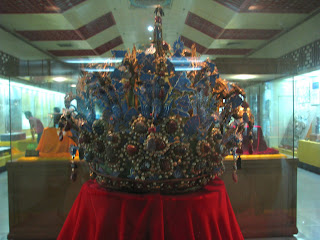As we left the Great Wall and headed for our next destination, the skies clouded over and the rain began. When we arrived at Dingling Ming Tomb there was still a light rain and a beautiful mist on the mountains.
It seemed to set the mood for a visit to a tomb. There were sixteen emperors during the Ming Dynasty and thirteen of them are buried in this valley.
We began our visit in a small exhibit hall where many of the artifacts that were unearthed in the tomb are on display.
The condition of these items would make you think that they were just constructed. The emperors did like their crowns and hats. It seemed there was a new one for every occasion. Included in the displays were paintings of the tomb area and all of the emperors.
This is a painting of the 13th Emperor of the Ming Dynasty Zhu yiJun and his second empress. The tomb actually housed the emperor and two empresses. The valley is quite large and as I said there are thirteen tombs. The area we walked through is all a part of the one excavated tomb.
There is a very long walkway which leads to the hill that the tomb is under. Along the way are several sets of steps and courtyards. Luckily they were even selling umbrellas as the rain picked up in intensity and the clouds were getting darker on the horizon.
This kiosk is actually a sedan chair that has been repurposed. You can see the bar at the back. Another would be placed through the ring on the front and servants would then carry the emperor in his chair. They must have been very strong and dedicated to carry out this task.
As you can see, the walk is long and quite beautiful. You can even rest on a elephant along the way.
When the excavations started, it took several attempts to find the correct entry into the tomb. I believe four attempts were made. This tunnel marks one of the failed attempts. After much searching a stone was found in the ground which held a clue to the location of the correct entrance.
As you can see from the diagram, the underground palace was built with five chambers. Where we entered (one of the side chambers) people still place money in tribute.
We proceded to the middle chamber where we saw some of the burial artifacts.
The large blue and white vessel was filled with oil and lit so that there would be light for the emperor. Of course, the tomb was sealed so tightly that no fresh oxygen could enter and when the tomb was opened most of the oil remained in the vessel. The tightness of the seal is easy to understand once you see the doors separating the chambers. There are so heavy that they had to be made thinner by the hinge so that they could be turned. There was a special piece made that allowed those who placed the emperor in the tomb to leave. Once this stone slipped into place, it could not be moved or accessed from the outside.
In the burial chamber itself there are replicas of the three caskets and the boxes which contained the items placed with the emperor and empresses upon their burials. The originals were partially decayed and the artifacts were removed for safekeeping and display.
As you walk through the central chambers you can look back and see the burial chamber and lantern vessel. A little further along you can see the correct entrance where access was finally made. The bricks were "unwoven" one by one until the tomb was revealed. I can only imagine what other treasurers and secrets are held in the remaining twelve tombs. From here it is a climb back to the surface and back into the rain.






















No comments:
Post a Comment